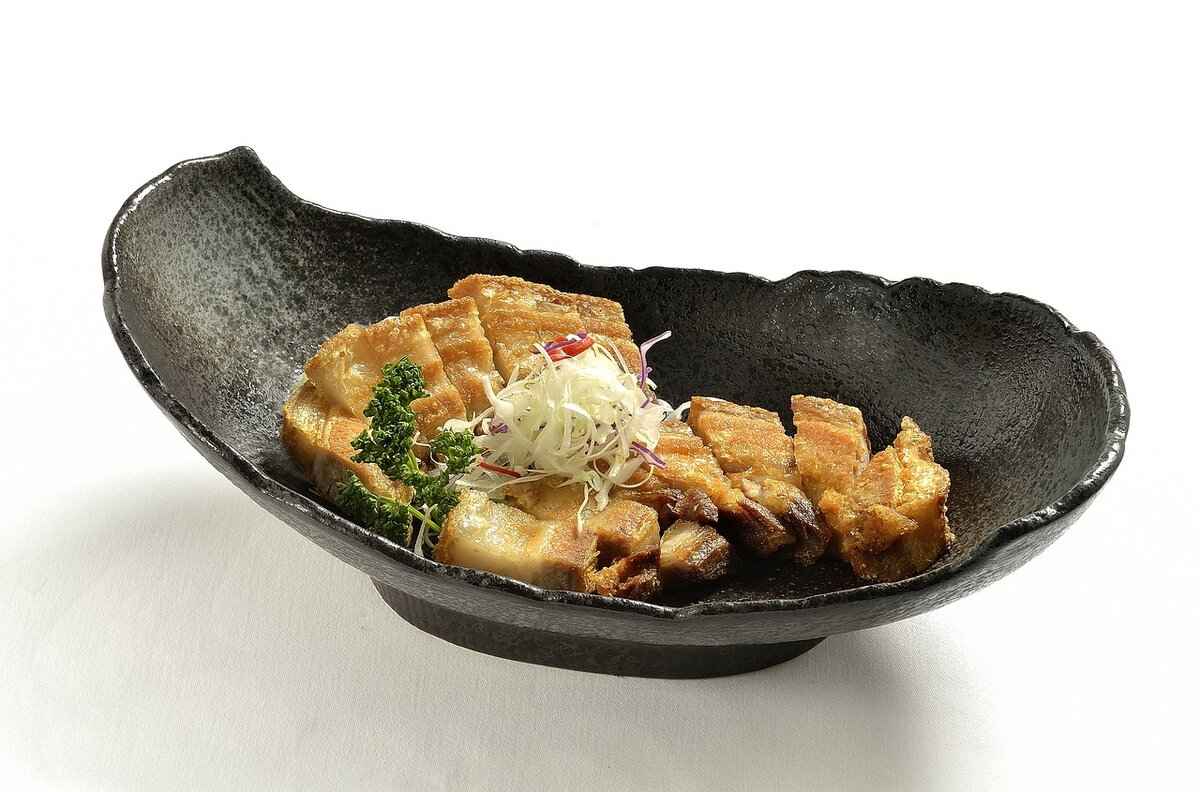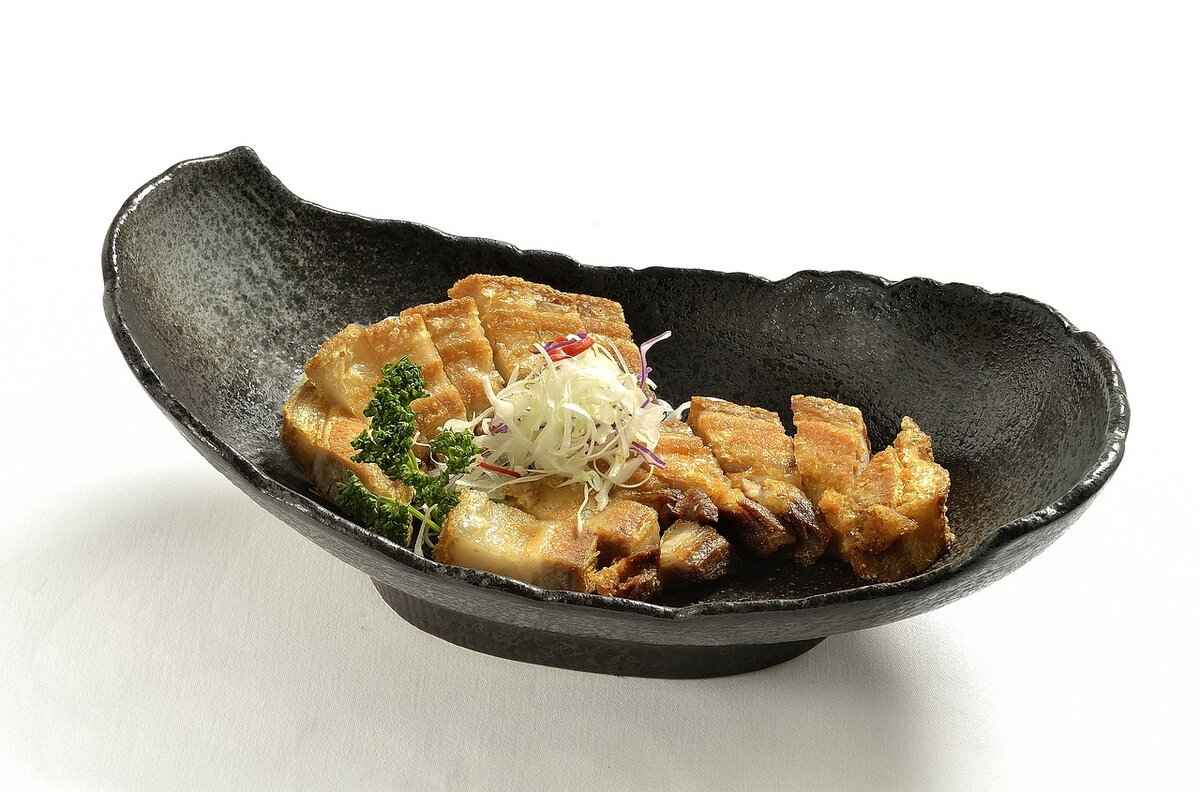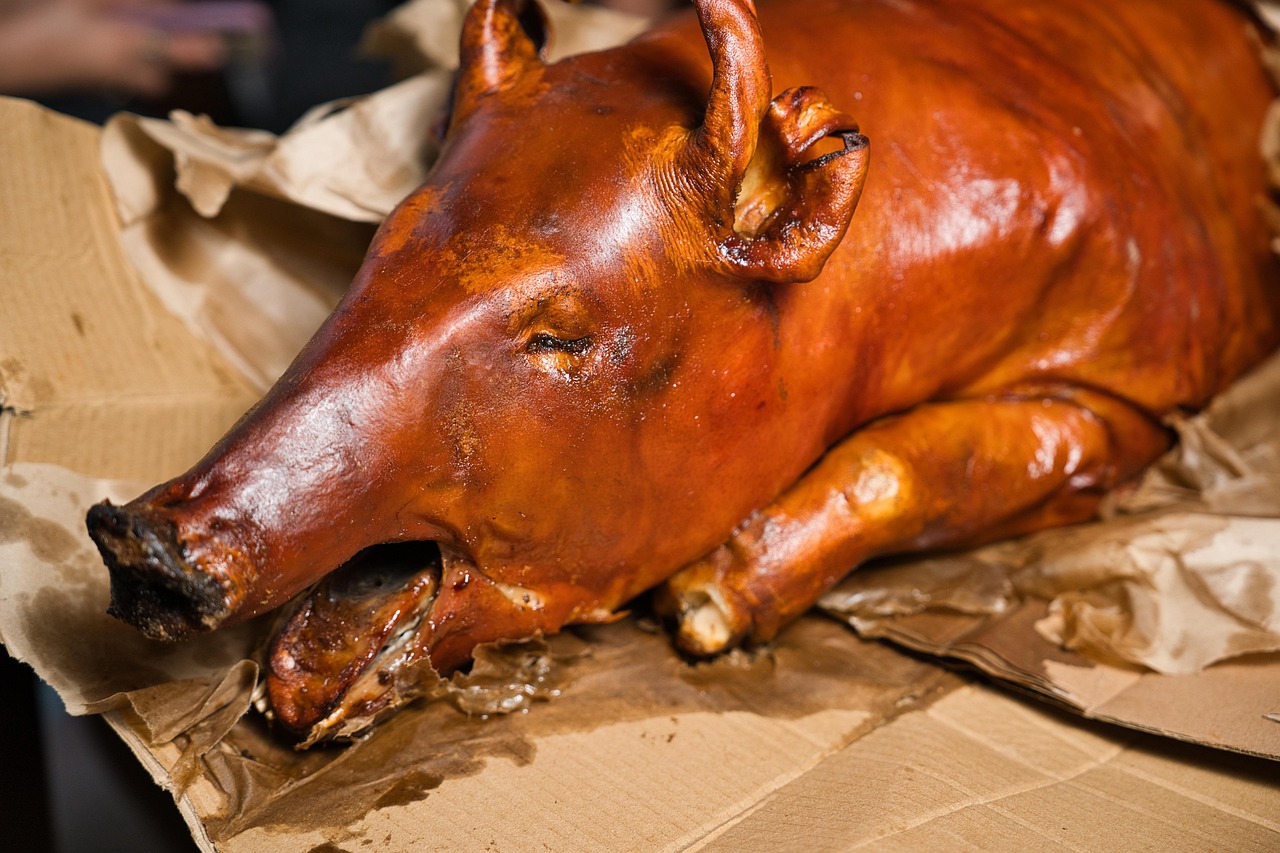Lechon is not just a dish; it is a cultural icon in the Philippines, representing the heart and soul of Filipino celebrations. This article delves into the cultural significance, preparation methods, and regional variations of Lechon, revealing why it is a staple at gatherings and its profound impact on Filipino cuisine.
Lechon, a whole roasted pig, is often the centerpiece of Filipino festivities. It is a symbol of abundance and joy, frequently featured in major events like weddings, birthdays, and Christmas. Its presence at these gatherings signifies not only a feast but also a deep-rooted tradition that brings families and communities together.
The preparation of Lechon is an art form that involves meticulous steps to ensure the perfect balance of flavor and texture. The process begins with marinating the pig, often infused with a mix of garlic, lemongrass, and soy sauce. After marination, the pig is slowly roasted over an open flame or in a specially designed oven, a method that allows the meat to remain juicy while achieving a crispy, golden-brown skin.
- Whole Pig: The star ingredient.
- Herbs and Spices: Essential for marinating.
- Garlic: Adds depth of flavor.
- Lemongrass: Provides a citrusy aroma.
- Soy Sauce: Enhances umami taste.
Lechon can be prepared using various techniques, including spit-roasting and oven-roasting. Each method offers a unique flavor profile and texture. Spit-roasting, often done outdoors, adds a smoky flavor, while oven-roasting allows for more controlled cooking, ensuring even doneness.
Across the Philippines, different regions have their own unique takes on Lechon, showcasing local flavors and traditions. For instance, Lechon Cebu is famous for its distinct seasoning, which includes a blend of spices that give it a unique taste. In contrast, Lechon Tagalog features a simpler marinade, allowing the natural flavors of the pork to shine through, often served with a rich liver sauce.
Serving Lechon is an event in itself. The pig is typically sliced into portions, showcasing the crispy skin and succulent meat. It is often accompanied by steamed rice, a variety of dipping sauces, and traditional condiments, enhancing the overall dining experience.
Complementing Lechon with the right side dishes can elevate the meal to new heights. Popular choices include:
- Pancit: A noodle dish that adds texture.
- Vegetable Dishes: To balance the richness.
- Steamed Rice: A staple that pairs well with Lechon.
While Lechon is undeniably delicious, it is important to note that it is high in fat and calories. Enjoying this dish in moderation is advisable, particularly given its festive nature. It is often reserved for special occasions, making it a treat rather than an everyday meal.
Discovering the best Lechon often requires exploring local markets, restaurants, and catering services known for their authentic preparation. Recommendations from locals can lead to hidden gems that serve this beloved dish. Whether in a bustling city or a quiet province, the quest for the perfect Lechon is a culinary adventure worth embarking on.

What is Lechon?
Lechon is a culinary masterpiece that showcases the rich traditions and vibrant culture of the Philippines. This beloved dish, featuring a whole roasted pig, is celebrated not only for its crispy skin and succulent meat but also for its deep-rooted significance in Filipino festivities. Often the centerpiece of grand celebrations, Lechon is synonymous with joy, abundance, and togetherness, making it a must-have at weddings, birthdays, and various holidays.
Lechon is more than just a dish; it is a symbol of Filipino hospitality and cultural pride. Its preparation is a labor of love, often involving family and friends coming together to create this iconic feast. The whole pig is typically marinated with a blend of traditional herbs and spices, which enhances its flavor and aroma. The process of roasting, whether over an open flame or in an oven, is crucial to achieving that perfect balance of crispy skin and tender, juicy meat.
The presence of Lechon at Filipino gatherings signifies not only culinary excellence but also the spirit of celebration. It represents abundance and is often associated with significant milestones in life. During festive occasions, the sight of Lechon being served evokes feelings of happiness and community, reinforcing social bonds among family and friends.
The preparation of Lechon is an intricate process that involves several steps:
- Marination: The pig is marinated for hours, sometimes days, to allow the flavors to penetrate the meat. Common ingredients include garlic, lemongrass, and soy sauce.
- Roasting: The marinated pig is then slowly roasted over a fire or in an oven. This method ensures that the skin becomes crispy while the meat remains juicy and flavorful.
- Serving: Once cooked, the pig is traditionally served whole, with the skin sliced to reveal the tender meat underneath.
Lechon varies significantly across the Philippines, with each region offering its unique twist on this traditional dish:
- Lechon Cebu: Known for its distinct flavor, this variation is often marinated with a special blend of spices and herbs, making it a favorite among locals and tourists alike.
- Lechon Tagalog: This version typically features a simpler marinade, allowing the natural flavors of the pork to shine. It is often served with a rich liver sauce that enhances the overall taste experience.
Serving Lechon is an art in itself. It is typically sliced into portions, with the crispy skin and tender meat served alongside a variety of side dishes. Common accompaniments include:
- Rice: A staple in Filipino meals, rice balances the richness of the Lechon.
- Pancit: This stir-fried noodle dish adds a delightful texture and flavor contrast.
- Vegetable Dishes: Fresh vegetables help to cut through the richness of the pork, providing a well-rounded meal.
While Lechon is undeniably delicious, it is important to consider its nutritional aspects. This dish is high in fat and calories, making moderation essential. Enjoying Lechon as part of a balanced diet, especially during festive occasions, allows for indulgence without compromising health.
To truly experience authentic Lechon, exploring local markets and renowned restaurants is key. Recommendations from locals can lead you to hidden gems where traditional preparation methods are still honored. Whether at a family gathering or a local eatery, the quest for the best Lechon is a delicious adventure.

Why is Lechon Important in Filipino Culture?
Lechon is not just a dish; it is a symbol of celebration and unity in Filipino culture. Its importance transcends mere gastronomy, embodying the spirit of Filipino gatherings and traditions. Understanding why Lechon holds such a significant place in Filipino culture requires an exploration of its role in various festivities and its connection to Filipino identity.
In the Philippines, Lechon is often the highlight of major celebrations such as weddings, birthdays, and religious holidays. Its presence at these events signifies abundance and prosperity, making it a must-have for any festive occasion. The act of gathering around a whole roasted pig is not just about the food; it is about family, friends, and community coming together to share joy and create lasting memories.
Lechon represents more than just a meal; it is a cultural icon that reflects Filipino values. The preparation and serving of Lechon are steeped in tradition, often involving generations of family members participating in the cooking process. This communal effort enhances the sense of belonging and shared heritage, reinforcing the bonds among family and friends.
During significant religious festivals like Fiesta, Lechon becomes a central offering, symbolizing gratitude and celebration. The dish is often prepared in large quantities to feed the community, showcasing the Filipino value of hospitality. This practice not only highlights the importance of sharing but also strengthens community ties and fosters a sense of unity among participants.
Different regions in the Philippines have developed unique styles of preparing Lechon, each with its own cultural significance. For example, Lechon Cebu is famous for its distinct flavors, often marinated in a special blend of spices. This regional variation highlights the diversity of Filipino cuisine and reflects local traditions and tastes. Similarly, Lechon Tagalog emphasizes simplicity, allowing the natural flavors of the pork to shine through, showcasing the regional pride in culinary heritage.
For many Filipino families, the preparation of Lechon is a cherished tradition passed down through generations. Families often gather to marinate, roast, and celebrate the dish, turning the cooking process into a festive event in itself. This tradition not only preserves culinary skills but also reinforces family bonds and creates lasting memories.
In a broader context, Lechon serves as a representation of Filipino identity. It embodies the warmth, hospitality, and rich cultural heritage of the Philippines. When Filipinos abroad gather for celebrations, Lechon often makes an appearance, serving as a reminder of home and cultural roots. This connection to Lechon helps maintain cultural ties, even in a foreign land.
Today, Lechon continues to hold a significant place in Filipino society, adapting to modern tastes while retaining its traditional essence. As globalization influences culinary practices, Lechon has found its way into various fusion dishes, showcasing its versatility and enduring popularity. Despite these changes, the core significance of Lechon as a symbol of celebration and unity remains intact, making it a beloved dish across generations.
In conclusion, Lechon is much more than just a roasted pig; it is a cultural cornerstone that embodies the spirit of Filipino celebrations. Its importance in Filipino culture is evident in its role as a centerpiece for gatherings, its symbolism of abundance, and its ability to bring people together. Whether enjoyed during a festive occasion or as part of family traditions, Lechon will always hold a special place in the hearts of Filipinos.

How is Lechon Prepared?
Lechon, the iconic Filipino roasted pig, is not just a dish; it is a culinary masterpiece that embodies the spirit of celebration in Filipino culture. The preparation of Lechon is an art form that requires skill, patience, and a deep understanding of flavors. This section delves into the meticulous process of preparing Lechon, highlighting the steps that transform a whole pig into a delectable centerpiece for any feast.
The preparation of Lechon begins with selecting a whole pig, typically weighing between 30 to 100 pounds, depending on the occasion and the number of guests. The quality of the pig is crucial, as it directly affects the flavor and texture of the final dish. Once the pig is procured, the next step is to marinate it, a process that is essential for infusing flavor into the meat.
- Marination: The marination process involves using a blend of traditional herbs and spices. Common ingredients include garlic, lemongrass, and soy sauce. These ingredients not only enhance the flavor but also contribute to the overall aroma of the dish.
- Preparation of the Pig: After marinating, the pig is cleaned thoroughly, and the insides are often filled with a mixture of spices and herbs to ensure that every bite is bursting with flavor.
Once the marination is complete, the next step is the cooking process. Lechon can be prepared using two primary methods: spit-roasting and oven-roasting.
- Spit-Roasting: This traditional method involves skewering the pig on a long rod and roasting it over an open flame. The pig is slowly rotated, allowing even cooking and ensuring that the skin becomes perfectly crispy. This method is often preferred for large gatherings as it adds a unique smoky flavor.
- Oven-Roasting: For those who may not have access to an open flame, oven-roasting is a viable alternative. The pig is placed in a specially designed oven, where it is cooked at a low temperature for several hours. This method also produces a crispy skin while keeping the meat juicy and tender.
The cooking process can take anywhere from 4 to 12 hours, depending on the size of the pig and the cooking method used. To achieve the perfect balance of crispy skin and tender meat, it is essential to monitor the temperature closely and baste the pig regularly with a mixture of its own juices and marinade.
As the pig roasts, the aroma fills the air, drawing people in and building anticipation for the feast to come. Once the Lechon is cooked to perfection, it is removed from the heat and allowed to rest for a short period. This resting time is crucial as it allows the juices to redistribute throughout the meat, ensuring that every slice is as flavorful as possible.
Finally, the Lechon is expertly carved, with the crispy skin being a prized part of the dish. It is often served with a variety of dipping sauces, including a tangy liver sauce or a spicy vinegar dip, which perfectly complements the rich flavors of the roasted pig.
In summary, the preparation of Lechon is a labor of love that involves careful marination, skilled cooking techniques, and an understanding of flavor profiles. This beloved dish not only represents the culinary heritage of the Philippines but also serves as a symbol of joy and celebration in every gathering.
Key Ingredients for Lechon
Lechon is a culinary masterpiece that embodies the rich flavors and traditions of Filipino cuisine. At the heart of this iconic dish lies a combination of key ingredients that not only enhance its taste but also contribute to its cultural significance. Understanding these ingredients is crucial for anyone looking to appreciate or recreate this beloved feast.
The main ingredients for Lechon include a whole pig, which serves as the centerpiece of the dish. This choice of meat is essential, as it ensures a succulent and flavorful outcome. The preparation involves a meticulous process of marinating the pig to infuse it with rich flavors. Among the most common seasonings used are:
- Garlic: Known for its robust flavor, garlic is a staple in Filipino cooking. It adds depth to the marinade and enhances the overall aroma of the roasted pig.
- Lemongrass: This aromatic herb contributes a refreshing citrusy flavor, balancing the richness of the pork. Its inclusion in the marinade is what sets the flavor profile of Lechon apart.
- Soy Sauce: This savory sauce is often used to marinate the pig, imparting a distinct umami flavor that complements the natural taste of the meat.
In addition to these primary ingredients, various traditional herbs and spices are often incorporated into the marinade. These may include:
- Black pepper: Adds a hint of heat and complexity.
- Bay leaves: Infuse the dish with a subtle aromatic flavor.
- Onions: Provide sweetness and depth to the marinade.
Once the pig is marinated, it is traditionally roasted over an open flame or in an oven. This cooking method is crucial, as it allows the skin to become crispy while the meat remains tender and juicy. The result is a delightful contrast in textures that is highly sought after in Filipino celebrations.
Regional variations of Lechon may introduce additional ingredients or unique marinades, reflecting the local culture and culinary practices. For instance, in Cebu, a special blend of spices is often used, making Lechon Cebu particularly famous for its distinct flavor and crispy skin.
Understanding these key ingredients not only enhances your appreciation for Lechon but also equips you with the knowledge to prepare this iconic dish authentically. Whether it’s for a festive gathering or a special occasion, the right combination of ingredients is essential for capturing the essence of this beloved Filipino delicacy.
Traditional Cooking Methods
Lechon is more than just a dish; it is a culinary masterpiece that represents the heart of Filipino culture. The preparation methods of Lechon, specifically spit-roasting and oven-roasting, play a crucial role in determining its flavor and texture. Each technique brings out different characteristics, making Lechon a versatile and beloved centerpiece at any celebration.
Spit-roasting is a traditional method that involves cooking the whole pig on a rotating spit over an open flame. This technique allows for even cooking, ensuring that every part of the pig is perfectly roasted. As the pig rotates, the skin becomes incredibly crispy, while the meat remains juicy and tender. The continuous exposure to the flame infuses the meat with a smoky flavor that is often sought after by enthusiasts.
On the other hand, oven-roasting offers a different approach. This method involves placing the pig in a large oven, where it is cooked at a controlled temperature. While oven-roasting may not achieve the same level of crispiness as spit-roasting, it allows for a more consistent cooking process. This method is particularly advantageous in urban settings where open flames may not be feasible. The result is a succulent roast with a tender texture, making it a popular choice for many households.
- Spit-Roasting: Smoky, crispy skin, and juicy meat.
- Oven-Roasting: Tender texture with a more subtle flavor.
Both methods have their merits, and the choice often comes down to personal preference or availability of resources. Some chefs even combine techniques, starting with spit-roasting for the first few hours and finishing in the oven to ensure thorough cooking.
Different regions in the Philippines have their own preferences when it comes to preparing Lechon. For instance, in Cebu, spit-roasting is the preferred method, celebrated for its ability to create that iconic crunchy skin. In contrast, urban areas may lean towards oven-roasting due to convenience and practicality.
Regardless of the cooking method, the marinade used significantly influences the flavor of Lechon. Common ingredients include garlic, lemongrass, and soy sauce. These ingredients are often combined to create a rich and aromatic infusion that penetrates the meat, enhancing its overall taste. The choice of marinade can vary by region, reflecting local culinary traditions and preferences.
The method of cooking Lechon not only affects its flavor and texture but also its cultural significance. Spit-roasting is often associated with larger celebrations, where the spectacle of cooking over an open flame adds to the festive atmosphere. In contrast, oven-roasting may be more common for smaller gatherings or family meals.
In conclusion, the preparation of Lechon through either spit-roasting or oven-roasting showcases the diversity and richness of Filipino culinary practices. Each method offers unique flavors and textures, making Lechon a dish that continues to evolve while remaining a beloved staple in Filipino culture.

Regional Variations of Lechon
Lechon is not just a dish; it is a cultural icon in the Philippines, celebrated for its rich flavors and communal significance. Each region in the Philippines has its own unique take on this beloved roasted pig, resulting in a variety of flavors, cooking techniques, and presentation styles that reflect local traditions and preferences. Understanding these regional variations adds depth to the appreciation of Lechon, allowing food enthusiasts to explore the diverse culinary landscape of the Philippines.
The uniqueness of Lechon across different regions lies in the ingredients used, the marination techniques, and the cooking methods. Each locality infuses its cultural identity into the dish, making it a reflection of the community’s heritage and tastes. Let’s explore some of the most notable regional variations:
One of the most famous variations is Lechon Cebu, originating from the Visayas region. This version is celebrated for its robust flavor, achieved through a special marinade that includes a blend of herbs and spices, particularly lemongrass and garlic. The pig is typically roasted over charcoal, resulting in a crispy skin that is golden brown and a tender, juicy interior. Lechon Cebu is often served during major celebrations and is a must-try for anyone visiting the region.
In contrast, Lechon Tagalog from the Luzon region showcases a more straightforward approach. The marinade is less complex, focusing on allowing the natural flavors of the pork to shine through. This version is often paired with a rich liver sauce, which enhances the dish’s flavor profile. The preparation method may vary, but it typically involves spit-roasting, which contributes to its delightful texture and taste.
Lechon Ilocos is another regional variation that stands out due to its unique flavor profile. This version often incorporates local ingredients such as vinegar and soy sauce in the marinade, giving it a tangy taste. The Ilocano style of cooking emphasizes the use of herbs like rosemary and oregano, which add a distinctive aroma and flavor. This variation is often served with a side of patis (fish sauce) for dipping, enhancing the overall dining experience.
In Bataan, the local take on Lechon is characterized by its use of a sweet marinade, often incorporating ingredients like pineapple juice and brown sugar. This results in a delightful balance of sweetness and savory flavors, making it a popular choice during festive occasions. The pig is usually roasted until the skin is perfectly crispy, making it a visually appealing centerpiece.
While traditional Lechon is a whole roasted pig, Lechon Manok offers a chicken alternative that is equally loved across the Philippines. This version is marinated with a blend of spices and then roasted to achieve a crispy skin and succulent meat. It is often served in local eateries and is a staple at family gatherings, showcasing the versatility of Lechon as a dish.
Understanding the regional variations of Lechon enhances the dining experience and appreciation for this iconic dish. Each region’s unique take reflects its cultural heritage, local ingredients, and culinary techniques, making every bite a journey through the Philippines’ rich culinary landscape. Whether you’re enjoying Lechon Cebu’s robust flavors or the simplicity of Lechon Tagalog, each variation tells a story that connects you to the local culture and traditions.
Lechon Cebu
is not just a dish; it is a culinary masterpiece that encapsulates the rich traditions and flavors of the Philippines. Known for its unique taste and preparation methods, this dish has gained a reputation that extends far beyond the shores of Cebu. It is a staple at various celebrations and gatherings, symbolizing not only festivity but also the pride of Filipino culinary heritage.
The distinct flavor of lies in its meticulous preparation. The pig is marinated with a special blend of herbs and spices, including lemongrass, garlic, and a mix of local seasonings. This marinade infuses the meat with a depth of flavor that is both savory and aromatic. The result is a dish that is celebrated for its crispy skin and juicy meat, making it a favorite among both locals and tourists.
The preparation of Lechon Cebu involves several key steps:
- Selection of the Pig: A healthy, young pig is chosen for roasting, ensuring the best quality of meat.
- Marination: The pig is marinated for several hours, allowing the flavors to penetrate deeply into the meat.
- Roasting: The pig is then roasted over an open flame or in a specially designed oven, which helps achieve the coveted crispy skin.
This slow-roasting process is crucial, as it locks in the juices while creating a tantalizingly crispy exterior.
For those visiting the Philippines, trying Lechon Cebu is a rite of passage. Its reputation has made it a must-try dish for anyone looking to experience authentic Filipino cuisine. The combination of flavors and textures creates a sensory experience that is hard to forget. Many locals will argue that no celebration is complete without this dish, highlighting its importance in Filipino culture.
If you’re eager to sample this delicacy, several places in Cebu are renowned for their Lechon. Look for local restaurants and markets that specialize in this dish. Some popular establishments include:
- Rico’s Lechon: Famous for its flavorful and crispy Lechon.
- Lechon by the Sea: Offers a unique twist with a seaside dining experience.
- House of Lechon: Known for its traditional preparation methods and rich flavors.
Exploring these venues not only satisfies your taste buds but also immerses you in the local culture.
To fully enjoy Lechon Cebu, consider pairing it with traditional side dishes. Some popular options include:
- Rice: A staple that complements the rich flavors of the Lechon.
- Pancit: Noodle dishes that add a delightful contrast in texture.
- Vegetable Dishes: Fresh salads or sautéed vegetables that balance the richness of the meat.
While Lechon Cebu is undeniably delicious, it is important to consider its nutritional content. The dish is high in fat and calories, so moderation is key. Enjoying it as part of a balanced diet is advisable, especially during festive occasions when it is typically served.
In summary, Lechon Cebu is a culinary treasure that offers a unique taste of Filipino culture. Its preparation, flavor, and significance in celebrations make it a dish worth trying. Whether you’re a local or a tourist, indulging in Lechon Cebu is an experience that you will cherish.
Lechon Tagalog
is a cherished variant of the iconic Filipino dish, Lechon, which features a whole roasted pig. What sets Lechon Tagalog apart is its emphasis on simplicity and the natural flavors of the pork, making it a favorite among many. This dish is often prepared with a straightforward marinade, allowing the inherent taste of the meat to shine through without overwhelming spices.
The marinade typically consists of basic ingredients such as salt, pepper, and garlic. These elements work together to enhance the pork’s flavor while maintaining its juicy texture. Unlike other regional variations that may incorporate complex spice blends, Lechon Tagalog focuses on the quality of the meat itself. This approach highlights the importance of selecting a well-raised pig, as the quality of the pork significantly impacts the final dish.
One of the defining features of Lechon Tagalog is its accompanying liver sauce. This sauce, often made from liver, vinegar, and spices, adds a rich and savory contrast to the crispy skin and tender meat. The combination of the roasted pork with the sweet and tangy liver sauce creates a delightful balance that enhances the overall taste experience.
When it comes to preparation, the process of cooking Lechon Tagalog involves marinating the pig for several hours to allow the flavors to penetrate the meat. Following the marination, the pig is roasted over an open flame or in a specialized oven. This slow roasting method is crucial, as it ensures that the skin becomes perfectly crispy while the meat remains succulent and tender. The result is a dish that is visually stunning and incredibly flavorful.
Lechon Tagalog is often served during significant celebrations such as weddings, birthdays, and holidays. Its presence at these gatherings symbolizes abundance and joy, making it a centerpiece of Filipino festivities. The dish not only satisfies the palate but also serves as a focal point for family and friends to come together and celebrate.
In terms of regional variations, while Lechon Tagalog is known for its simplicity, other regions in the Philippines may offer their unique twists. For instance, Lechon Cebu is famous for its complex marinade that includes a variety of spices and herbs, resulting in a different flavor profile. Understanding these variations adds depth to the appreciation of Lechon Tagalog and its place within Filipino cuisine.
When serving Lechon Tagalog, presentation is key. The pig is often displayed whole, showcasing its golden-brown crispy skin. It is typically sliced into portions, allowing guests to enjoy both the skin and the tender meat. Common side dishes served alongside Lechon Tagalog include steamed rice, pancit (noodles), and a variety of vegetable dishes, which help to balance the richness of the roasted pork.
While indulging in Lechon Tagalog is a delightful experience, it is essential to be mindful of its nutritional content. The dish is relatively high in fat and calories, so moderation is advised, especially when enjoyed during festive occasions. However, the joy and satisfaction it brings to gatherings make it a beloved treat for many.
For those looking to experience authentic Lechon Tagalog, exploring local markets and restaurants known for their traditional preparation is highly recommended. Often, the best recommendations come from locals who can guide you to hidden gems that serve this delectable dish.
In summary, Lechon Tagalog is more than just a dish; it is a symbol of Filipino culture and tradition. Its straightforward marinade allows the natural flavors of the pork to shine, while the accompanying liver sauce enhances the overall taste experience. Whether enjoyed at a festive gathering or a casual family meal, Lechon Tagalog holds a special place in the hearts of many Filipinos.

How to Serve Lechon?
Serving Lechon is an art that goes beyond simply slicing meat; it is a celebration of flavor, culture, and community. This traditional Filipino dish, known for its crispy skin and succulent meat, deserves a thoughtful presentation that enhances its appeal during gatherings. Here’s a detailed guide on how to serve Lechon effectively, ensuring that every bite is a memorable experience.
Before serving, it is essential to prepare both the Lechon and the dining area. Here are some key steps:
- Presentation Platter: Choose a large, attractive platter that can accommodate the whole roasted pig or its parts. A wooden or bamboo platter can add a rustic touch.
- Garnishes: Fresh herbs like parsley or coriander can be used to decorate the platter, adding a pop of color.
- Serving Utensils: Ensure you have sharp knives and serving forks ready for slicing and serving the meat.
Slicing Lechon requires skill to maintain the integrity of the crispy skin while ensuring tender meat is served. Follow these steps:
- Start with the Skin: Carefully slice through the crispy skin using a sharp knife. Aim for even pieces to maintain presentation.
- Cut the Meat: After the skin, move to the meat. Cut into generous portions, ensuring each piece has a bit of skin attached.
- Arrange Neatly: Place the sliced pieces back on the platter in an organized manner, alternating between skin and meat for visual appeal.
Lechon is often served with a variety of side dishes and sauces that complement its rich flavors:
- Rice: Steamed white rice is a classic choice that balances the savory taste of Lechon.
- Dipping Sauces: Serve with traditional sauces like liver sauce or vinegar with garlic to enhance the flavor.
- Vegetable Dishes: Side dishes such as pinakbet or ensalada can provide a refreshing contrast to the richness of the meat.
The presentation of Lechon plays a crucial role in the overall dining experience. Here are some tips:
- Table Setting: Create an inviting atmosphere with colorful table settings, including plates, napkins, and utensils that match the festive occasion.
- Lighting: Use warm lighting to create a cozy ambiance, making the meal feel more special.
- Sharing Tradition: Encourage diners to share and serve each other, fostering a sense of community and togetherness.
By following these guidelines, serving Lechon becomes a delightful experience that celebrates Filipino culture and culinary tradition. Whether at a wedding, birthday, or any festive gathering, the way Lechon is served can elevate the meal, making it a highlight of the celebration.

What are the Best Side Dishes for Lechon?
When it comes to enjoying Lechon, the iconic Filipino roasted pig, the experience is often elevated by the choice of side dishes. The right accompaniments not only enhance the flavors of the Lechon but also provide a balance to its rich and savory profile. Below are some of the best side dishes that complement this beloved dish, ensuring a well-rounded and satisfying meal.
Side dishes play a crucial role in Filipino feasts, especially when serving Lechon. They help to balance the richness of the roasted pig and offer a variety of textures and flavors. Additionally, they contribute to the overall presentation of the meal, making it visually appealing.
- Steamed Rice: A staple in Filipino cuisine, steamed rice is the most common side dish served with Lechon. It acts as a neutral base that absorbs the savory juices of the meat.
- Pancit: This traditional noodle dish comes in various forms, such as Pancit Canton or Pancit Bihon. It provides a delightful contrast to the crispy skin of the Lechon and adds a burst of flavor.
- Vegetable Dishes: Dishes like Pinakbet or Chopsuey are excellent choices. They introduce a medley of vegetables that not only enhance the meal’s nutritional value but also add freshness to the plate.
- Atchara: This pickled papaya salad is a tangy and refreshing side that cuts through the richness of the Lechon. Its sweet and sour flavor profile complements the savory notes of the pork.
- Liver Sauce: Often served alongside Lechon, this sauce adds a creamy texture and a rich flavor that enhances the overall taste experience.
When selecting side dishes to accompany Lechon, consider a few key factors:
- Flavor Balance: Aim for dishes that offer contrasting flavors. The richness of Lechon pairs well with fresh and tangy accompaniments.
- Texture Variety: Incorporate a mix of textures, such as crunchy, creamy, and soft, to create a more enjoyable dining experience.
- Color Presentation: Choose side dishes that add vibrant colors to the plate, making the meal visually appealing.
Absolutely! While traditional sides are fantastic, you can also experiment with modern interpretations. For example, consider serving truffle mashed potatoes or a quinoa salad for a contemporary twist. These options can provide a unique take on the classic Lechon experience.
The choice of drinks can further enhance your Lechon meal. Popular options include:
- Calamansi Juice: This refreshing citrus drink complements the flavors of Lechon beautifully.
- Beer: A cold beer can be a perfect pairing, cutting through the richness of the dish.
- Fruit Juices: Juices like mango or pineapple offer a sweet contrast to the savory meat.
In summary, choosing the right side dishes for Lechon is essential for creating a memorable dining experience. By balancing flavors, textures, and colors, you can elevate this iconic Filipino dish to new heights. Whether you stick to traditional sides or venture into creative territory, the combination of Lechon and its accompaniments is sure to delight your guests and celebrate Filipino culinary heritage.

Is Lechon Healthy?
Lechon, the iconic Filipino roasted pig, is not just a culinary delight but also a staple in various celebrations across the Philippines. While it’s often the centerpiece of festive gatherings, many people wonder about its health implications. Understanding the nutritional aspects of Lechon is essential for anyone looking to indulge in this savory dish.
Lechon is primarily made from a whole pig, which means it contains a significant amount of fat. The cooking process, typically involving slow roasting, allows the fat to render, resulting in that crispy skin that many love. However, this also means that a serving of Lechon can be quite high in calories. For instance, a standard serving can contain anywhere from 400 to 700 calories, depending on the portion size and the specific cut of meat.
Given its high-fat content, moderation is crucial when enjoying Lechon. Regular consumption of high-fat foods can lead to various health issues, including heart disease and obesity. It’s essential to balance indulgence with healthier options. Pairing Lechon with fresh vegetables or salads can help mitigate some of the negative health effects while still allowing you to enjoy this traditional dish.
- Choose Lean Cuts: Opt for leaner cuts of pork when available.
- Control Portion Sizes: Enjoy smaller servings to reduce calorie intake.
- Accompany with Healthy Sides: Serve with vegetable dishes or whole grains to balance the meal.
- Limit Sauces: Be cautious with rich sauces that can add extra calories.
Despite its high-fat content, Lechon does offer some nutritional benefits. It is a good source of protein, essential for muscle repair and growth. Additionally, when prepared with traditional herbs and spices, such as lemongrass and garlic, it can provide antioxidants that may contribute to overall health.
Absolutely! The key is to enjoy Lechon as an occasional treat rather than a regular part of your diet. By practicing mindful eating and making conscious choices about portion sizes and accompanying dishes, you can savor the flavors of Lechon without compromising your health.
When indulging in Lechon, remember that it’s not just about the food; it’s about the experience and the celebration that comes with it. Enjoying this dish in the company of friends and family can enhance the overall experience. Just be sure to balance it with a healthy lifestyle that includes regular exercise and a variety of other foods.
In conclusion, while Lechon is undeniably high in fat and calories, it can still have a place in a balanced diet. By enjoying it in moderation and being mindful of your overall dietary choices, you can relish the rich flavors of this beloved Filipino dish without compromising your health.

Where to Find the Best Lechon?
When it comes to experiencing the rich culinary heritage of the Philippines, Lechon stands out as a must-try dish. Its crispy skin and succulent meat make it a favorite for many. However, finding the best Lechon can be a delightful adventure that requires some exploration and local insight.
Finding the best Lechon often involves exploring local markets, restaurants, and catering services that are renowned for their traditional preparation methods. Each region in the Philippines has its own unique twist on this beloved dish, making the search even more exciting.
- Local Markets: Visiting local markets is a fantastic way to discover hidden gems. Here, you can find vendors who specialize in Lechon, often using family recipes passed down through generations. Engaging with the vendors can also provide insights into the preparation process and the best times to enjoy freshly roasted Lechon.
- Restaurants: Many restaurants across the Philippines pride themselves on their Lechon offerings. Some establishments even have Lechon as their signature dish, attracting both locals and tourists. Look for restaurants that have received rave reviews for their Lechon, and don’t hesitate to ask the staff for recommendations.
- Catering Services: For larger gatherings or special occasions, catering services specializing in Lechon can be a great option. These services often provide a whole roasted pig, perfectly prepared and ready for your celebration. Many caterers offer customizable packages to suit your event’s needs.
One of the best ways to find exceptional Lechon is through recommendations from locals. Locals often have insider knowledge of the best spots, including hidden treasures that may not be listed in guidebooks or online reviews. Engaging with the community can lead you to places where the Lechon is not only delicious but also steeped in tradition.
Consider joining local food tours or asking for suggestions on social media platforms. Many food enthusiasts share their experiences online, providing valuable tips on where to find the best Lechon in various regions. This community-driven approach can enhance your culinary adventure and ensure that you taste the most authentic versions of this iconic dish.
When searching for the best Lechon, there are several factors to consider:
- Crispy Skin: The hallmark of great Lechon is its crispy skin. Look for vendors who prioritize achieving that perfect crackling texture.
- Flavorful Marinade: The marinade can significantly influence the taste. Traditional seasonings like garlic, lemongrass, and soy sauce are commonly used, so inquire about the ingredients to ensure a rich flavor profile.
- Juicy Meat: The meat should be tender and juicy, a result of proper roasting techniques. Ask about the cooking method to ensure you’re getting the best quality.
By focusing on these aspects and being open to local recommendations, you can enhance your chances of finding the best Lechon that meets your taste preferences.
In summary, the journey to discover the best Lechon is as rewarding as the dish itself. By exploring local markets, restaurants, and catering services, and by seeking recommendations from locals, you can uncover the true essence of this Filipino culinary treasure.
Frequently Asked Questions
- What makes Lechon special?
Lechon is more than just a dish; it’s a symbol of celebration and joy in Filipino culture. Its crispy skin and tender meat make it a showstopper at any gathering!
- How long does it take to prepare Lechon?
The preparation of Lechon can take several hours, depending on the cooking method. Spit-roasting might take up to 6 hours, while oven-roasting can vary, but patience is key for that perfect crispy skin!
- Can Lechon be made with different meats?
While traditional Lechon uses a whole pig, variations exist that use other meats like chicken or even goat. Each brings a unique flavor and texture to the table!
- What are the best sauces to serve with Lechon?
Lechon is often paired with a rich liver sauce, vinegar dipping sauce, or even a sweet soy sauce. These add an exciting flavor contrast to the savory meat!
- Is Lechon suitable for everyday meals?
Lechon is a festive dish, usually reserved for special occasions. It’s rich and indulgent, so while it’s delicious, moderation is key!














